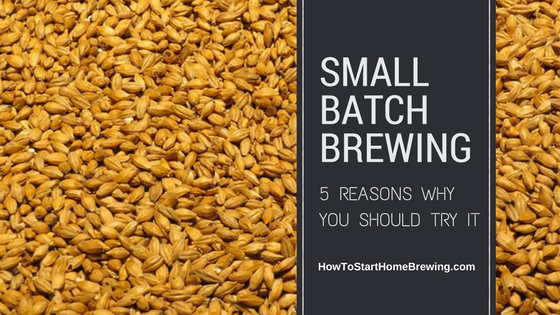Small batch brewing. It’s a phrase that generates a lot of discussions, both good and bad.
Some homebrewers are all about it, while others are severely against it. To each their own, I say.
If you haven’t already guessed, I’m “one of those guys” who is strictly a small-batch brewer.
Record scratches…
Honestly, if it wasn’t for the ability to brew beer in small batch sizes, I don’t know if I would be as into the hobby as I am now.
It Wasn’t Always Sunshine & Small Batches
Like a lot of beginners, I started out brewing 5 gallon batches with a buddy of mine. It worked out great for the fact that we split up the beers between us. Roughly 24 a piece after all was said and done. Not bad.
We would continue to brew batches as our schedules allowed. Got in maybe 6 to 7 batches total that first year. Over time, our families started to grow and our schedules had trouble syncing up. Brewing became less frequent.
Then, my basement had a sewage backup that not only ruined our finished basement, but wiped out ALL my equipment. That shit sucked (literally)!
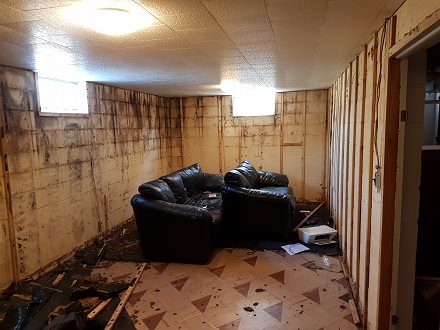
After taking a few months to deal with the city (thankfully, they paid my claim since it was their fault due to a blockage in the sewer) and rebuild everything, the itch to brew was strong. With my friend being busy with life and his first kid on the way, I decided to branch off on my own.
I had read a lot about brewing in small batch sizes. With 3 young and active kids, a wife, and my career, the idea that I could save some time and do everything from my kitchen was attractive.
After doing some research, I bought all new equipment and got my started with my very first recipe – a Chocolate Wheat beer.
And that, my friends, was exactly what started me on this epic journey I am currently on today!
Why Small Batch Brewing is a Game Changer
If you’re laughing at this right now, just hear me out for a second.
When I joined my brew club, most of the guys thought I was crazy and that I was wasting my time with small batches. I’ve heard all the arguments against it.
Let me make this clear: If you prefer standard (or larger) batch sizes and that works for you, that’s great! I’m in no way dogging those who do that. Most guys and gals prefer these standard sizes, and I totally get it.
However, if you:
- Are new to brewing and/or limited on space and storage.
- Are short on time and want to wrap up a brew day within 3.5 hours from start to finish.
- Don’t want to commit to drinking 5 gallons of beer at a time before you brew again.
- Want to experiment and brew a variety of beers that you can reasonably drink (and share).
- If bottling, don’t want to package and store 50+ bottles at a time.
Then small batch brewing might be right up your alley!
5 Reasons to Try Brewing Small Batches
Here is a more detailed breakdown of the top reasons why I think brewing smaller batches is worth a shot:
#1 – Ability to experiment on a small scale without committing to a full 5 gallons (or more).
Whether you’re a standard batch size brewer who wants to experiment or someone who just wants to experiment in general without committing to a large batch size, small batches make it easy.
Think of it like how an actual brewery would use a pilot system. Commercial breweries use these smaller pilot setups to try out new and exciting recipes without committing to a massive batch.
Once their recipes are refined, fully-tested and well-received from the public, the recipe is then scaled up to a regular production size. It minimizes some of the risk without taking away the ability to experiment.
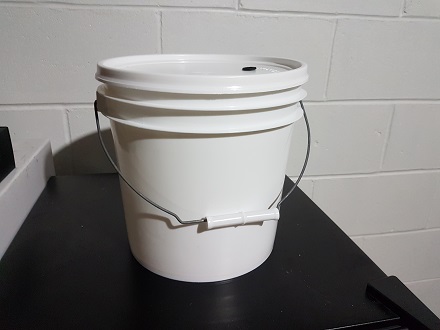
In other words, small batches allow you to get things right with less waste. In my personal opinion, it feels better dumping out 1.5 gallons of a failed experiment over 5+ gallons any day!
Look at it this way: If your beer turns out stellar time and time again, you can confidently scale that recipe into larger batches. I currently keg my batches in 1.75 gallon kegs, but I plan to snag a couple 5 gallon kegs for my medal winning recipes that tend to go VERY quick.
#2 – Saves a little bit of time
One of the main arguments I hear from those who brew standard batches is that small batch brewing takes just as much time.
In fact, some brewers that are short on time say they prefer to do even larger batches so that they don’t have to brew as often.
If you don’t like variety and prefer to brew less, then rock on! But what about the guys who want to brew and brew often, yet don’t have much time?
Small batches are the answer!
And believe it or not, it actually does save time. Here’s how:
- I can brew everything in my kitchen without having to brew on propane and setup everything outdoors.
- My equipment is smaller, so there is less surface area to clean. Also, there is less volume to heat (strike water and boil).
- I use the BIAB method. No sparging, no hot liquor tank, transferring, whirpooling, and so on.
- Once my brew day is wrapped up, I only have my wort chiller and kettle left to clean. The smaller size makes it easier to clean things as I go, which is super convenient when I’m running low on time.
- If bottling, there is less to prep and fill. Much easier to clean and fill 15 bottles over 48-50 each batch.
Sure, you’re not going to save hours on end, but it does help streamline everything.
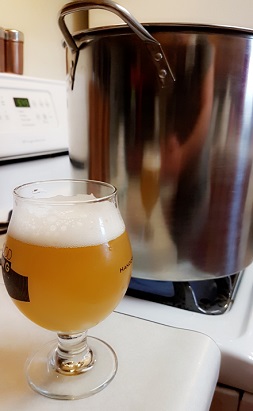
Less to clean up, less to bottle, and less to store. I typically get my 1.5 gallon brew days done in roughly 3.5 hours from start to finish (including setup, take down, and cleaning).
I recently just made the switch to kegs and keg all of my batches now (unless they are beers that need aged, which I still bottle condition). Going this route has saved me even more time. Getting a small batch kegged takes me about 10 minutes. I also love the portability of the small kegs. Makes it a piece of cake to haul to an event or brew club meeting.
Remember – 3 kids and a busy family life means I can be tight on time at times. Brewing like this allows me to squeeze in several brew days a month without dramatically impacting much else.
As a competitive brewer who started competing frequently in the last 5 months, I can brew a TON and still make commitments and spend time with family. Can’t beat it, really.
If you’re short on time, seriously, this is the way to do it!
#3 – It’s perfect for small spaces
If you have a small kitchen (like me) or have don’t have the room to store off hundreds of bottles or large kegs, you’re not alone. Many aspiring brewers find themselves in tight spaces, making it hard to brew and store a variety of beer.
One of the biggest reasons I love brewing smaller batches is that it removes the restraints of limited space.
A standard 5 gallon stockpot makes it easy to brew directly on your stovetop. Big enough to achieve a full, rolling boil, yet small enough to work with.
Fancy and shiny equipment is nice and all, but you don’t need a state-of-the-art 3-tier rig to make excellent beer. Hell, I’ve won several medals in the last 5 months of competitive brewing from a simple stockpot and a brew bag.
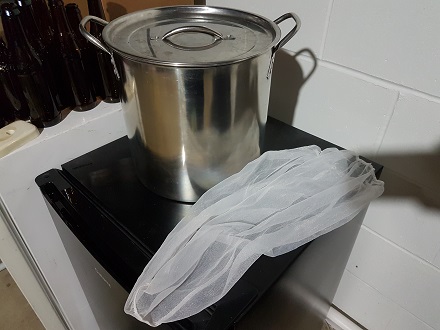
I know a lot of guys that are limited in space and brew larger batches, but they have minimal storage. As a result, they can’t brew as frequently as they’d like.
For example, if you brewed (3) 1.5 gallon batches, you’d have nearly as much beer as you would with a standard 5 gallon batch. The difference? You have 3 varieties on hand, rather than 1.
That’s 3 varieties of beer taking up just as much room as what a standard batch would.
One thing to note: If you’re kegging, you can argue that 3 smaller kegs will take up more space than one larger one. While that might be true, I have found that something like these Torpedo kegs (which are stackable) make the difference negligible at best.
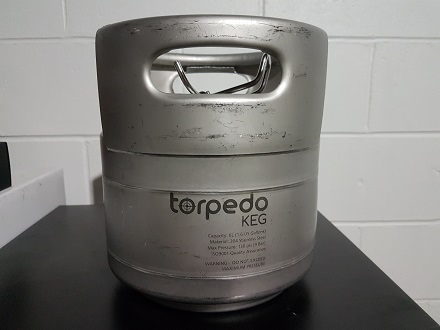
Oh, and if you have a gas stove, then you’re in a prime position. When my wife and I bought our house nearly 3 years ago, it came with a gas stove. I’ve only used electric before that, but man, I will never go back to it again if I can help it!
#4 – Great way to dive into all-grain brewing without the large commitment upfront
Aside from a small percentage of new homebrewers, most start out their journey with extract. It’s one of the easiest ways to brew and saves a lot of time (as there is no mash involved, other than steeping specialty grains for flavor and color).
Unfortunately, extract brewing comes with its own set of limitations. Total control can be harder to achieve, especially when trying to hit a certain SRM, such as with lighter styles.
All-grain brewing puts the control in your hands; however, some brewers are hesitant to take the leap.
That’s where the BIAB (brew in a bag) method becomes a clear winner.
Brewing in a bag allows you the freedom of going all-grain without a large commitment.
How? You can mash and boil directly in your kettle!
And no, you don’t need a mash tun or other large pieces of equipment. Just a cheap boil kettle and a fine mesh bag to hold your grain will do the trick.
By utilizing BIAB and using smaller equipment, it makes it easy to jump into the world of all-grain brewing with no size or space limitations. No matter how big or small your space is, all-grain brewing can be easily had.
Hell, if you already have a beginners brewing kit, you can start brewing all-grain in small batches right away!
Even if you decide that you want to start brewing larger batches, starting off small helps you test the waters. By doing this, you’ll be able to refine your process and work out any kinks. It’ll make the jump to larger batch sizes much less of a headache!
#5 – Crank out more variety without taking on larger costs and storage capacity
I know I’ve mentioned this above, but honestly, this is my favorite part about brewing small batch sizes. It affords me the ability to make a variety of beers without taking up a ton of storage or significant costs.
Think about it – you gain more variety while keeping storage the same (roughly 15 bottles per batch).
That will allow you to brew more frequently, which again, gives you more variety to choose from on a regular basis.
More variety also means you get to brew more often. It’s truly the only way to flex your brewing skills and get better as a whole. It forces you to learn to brew new styles and tackle different processes, which I think is crucial if you want to grow as a brewer in general.
There is no way I could do larger batch sizes without having to figure out where to store everything (not to mention drink it all). Besides, I couldn’t keep up with the costs of 5 gallon batches if I were to brew at the same frequency as I do now, and I’m not willing to slow down and keep experimenting. That’s half the fun!
At the end of the day, smaller batch sizes give me an amount that’s perfect for ME. There is plenty for me to share with others and use for competitions, leaving just enough for me to enjoy.
What’s Your Take?
Whether you’re already doing something similar, are totally against small batch brewing, or you’re looking to jump into the small batch world, let us know what you think in the comments below!

